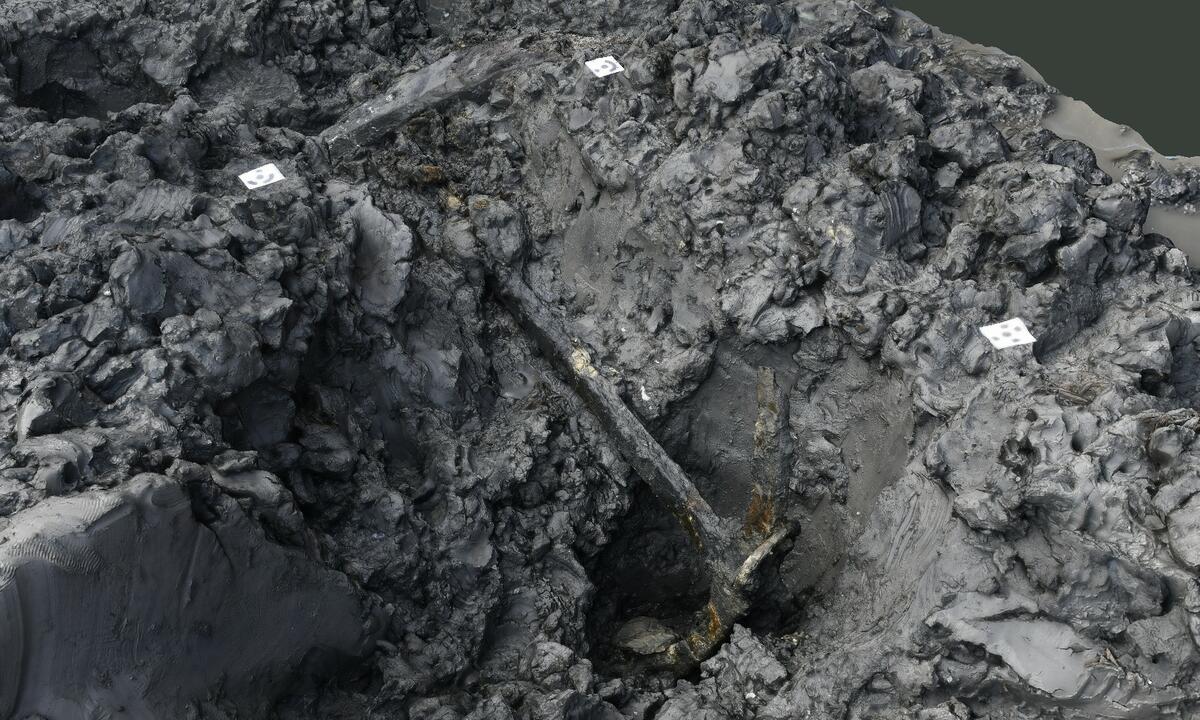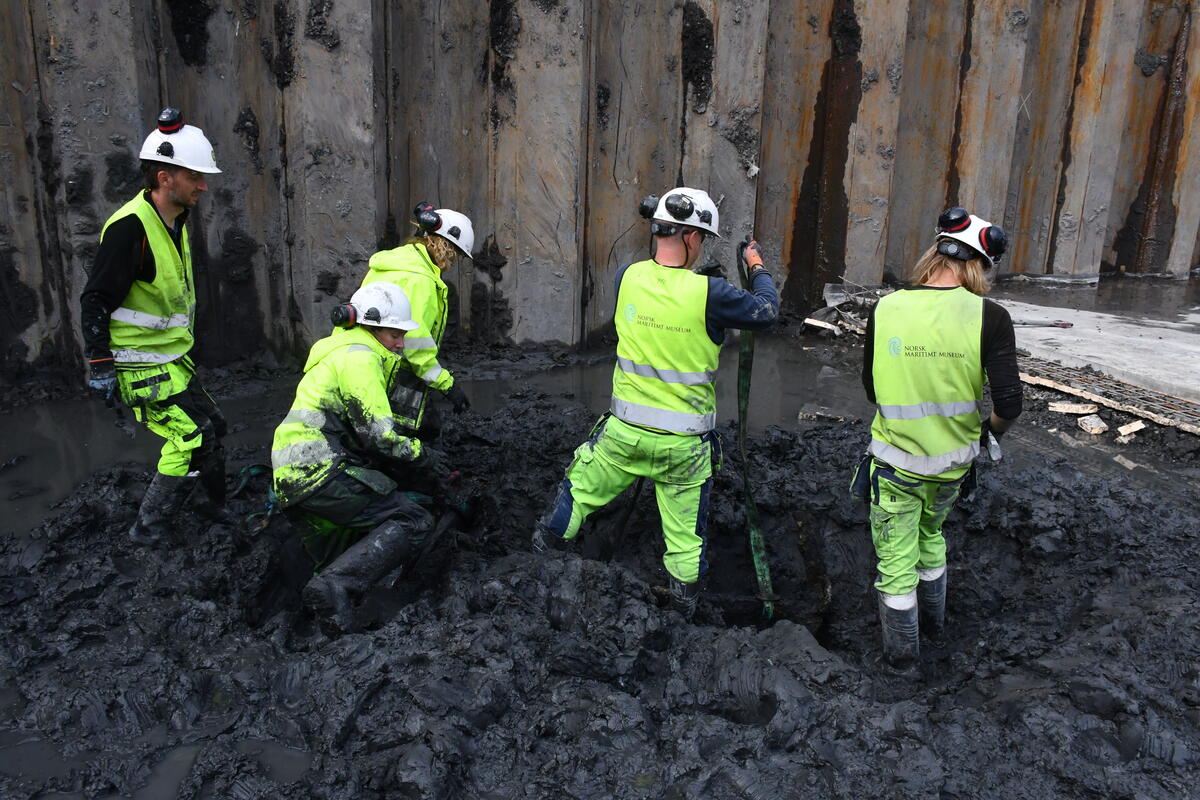- 1/1
Fig.1. Photogrammetry of 14th century anchor (F228) found in Oslo harbour Sjoerd van Riel / NMM
Anchors come in all shapes, sizes, and materials. The earliest anchors were simply made, with stones and rope. Some early anchors incorporated wood that could lodge itself on the seafloor allowing boats to moor safely. Anchors progressed in complexity, but simpler anchor types were utilised long after more advanced iron anchors were developed, existing alongside each other for centuries.
Already in the Roman period iron anchors with removable stocks were in use. However, most of the anchors we have found on our excavations over the past 15 years in Oslo are the more basic stone anchors called killicks (Fig.2). The majority of the killicks we have found have been dated to the 16th century. Killicks were made with a large stone, which sat on two crossed wooden arms (killick claws) and was enclosed within bent wooden rods.
- 1/1
Fig. 2. Killick F151 is one of many stone and wood anchors excavated by the Norwegian Maritime Museum in Oslo. Sjoerd van Riel / NMM
While it has been wonderful to find these killicks, we had begun to wonder: where have all of the lost iron anchors gotten to? Tantalisingly last week we began to find anchor stocks, one after the other in the same part of our excavation field and in the same soil layer so that we knew they dated to the same period, around the 14th century. On and around these wooden stocks we found thick rope. Many of the stocks were badly eaten by shipworm. But their function was clear, they were made of two heavy oak parts trenailed together with a rebate for the shank of an iron anchor. The iron parts of the anchors however were nowhere to be seen. It was some consolation when we found a beautiful owner’s mark on one of these stocks.
- 1/1
Fig.3. Owner's mark on stock F213 shown within a blue circle. The mark is a triangle with an 'X' in the centre. Andrew Stanek / NMM
With just a single section left to dig in this area, we thought we had picked up a metal signal near a length of wood that looked like a handle, could it be an axe? It was carefully excavated but the metal signal disappeared, and the wooden handle revealed itself to be (dramatic pause) a stick. We gave up on the section leaving one lone archaeologist, Christian, to watch as the digger finished its work. Christian took a last sweep with the metal detector before giving the go ahead for the concrete to be poured, and there it was again, the metal signal. Fast forward through a lot of mud and confusion and we had finally found a lost iron anchor.
- 1/1
Fig.4. The confusion and mud, trying to reveal the anchor. Sjoerd van Riel / NMM
At around 700 years old the anchor is in fantastic condition (Fig.1 & Fig.2). It is 2 meters long with a stock that is about 1.6 meters long. It consists of the oak stock, a shank, arms with one fluke, and a ring that was attached to the crown (between the arms) of the anchor. There was also a lot of rope around the anchor. We found a large lumps of loose concretion too, which is probably what is left of the missing ring, from above the stock, and the missing fluke from one of the arms. The stock of the anchor was at a right angle to the arms of the anchor, which allowed one of the flukes to bury itself in the sea floor. The higher up part of the stock was quite eaten by shipworm but more than half of it is in good condition so that we can estimate it was 160 cm long. The stock is 15 cm thick in the middle but narrows to 9 cm at the ends. The shank of the anchor is 170 cm long between the stock and the arms, it is rectangular in section with a thickness and height of 4 cm x 7 cm. The anchor arms are about 100 cm long, but we will need to reconstruct the shape somewhat due to the missing fluke to know to get an exact measurement.
- 1/1
Fig.5. F228 photogrammetry of 14th century anchor found in Oslo Harbour Sarah Fawsitt / NMM
The anchor has now been sent to the conservation department at the Norwegian Maritime Museum. There it will be cleaned, and stabilised, and documented more fully. Then we will be able to see the anchor more clearly to get a better sense of its original shape. We are still mulling the question of where all of the other iron anchors have gone. Why have we found so few and how were the stocks we did find separated from their iron parts? The sea floor where the anchors were found were free of rocks and other obstructions that might have trapped the anchors. This may explain why we have found so few lost anchors in Oslo Harbour. It does not explain, however, the deconstructed anchors. It may have been the work of shipworm, eating through the wooden stocks loosening them from their iron shanks. Perhaps the loosened iron elements have sunk deeper into the clay, unanchored by their wooden stocks.
Further reading
Kapitän, Gerhard. “Ancient anchors—technology and classification*.” International Journal of Nautical Archaeology 13 (1984): 33-44. https://uw-archaeology.at.ua/_ld/0/10_Kapitan_G-Ancie.pdf.
Dictionary of Newfoundland English, Edited by G.M Story, W.J Kirwin and J. D. A Widdowson. Second Edition with Supplement. https://www.heritage.nf.ca/dictionary/index.php#2509.
Historic Naval Ships Association, ANCHOR-MAKING.-Vol. I., https://www.hnsa.org/manuals-documents/age-of-sail/the-elements-and-practice-of-rigging-and-seamanship/anchor-making-vol-i/
The Vasa Museum, Owner’s Marks, https://www.vasamuseet.se/en/explore/collections/find-in-focus/ownerss-marks
Boating Magazine, Uncommon Nautical Words to Describe Anchoring a Boat,
https://www.boatingmag.com/uncommon-nautical-words-to-describe-anchoring-boat/




